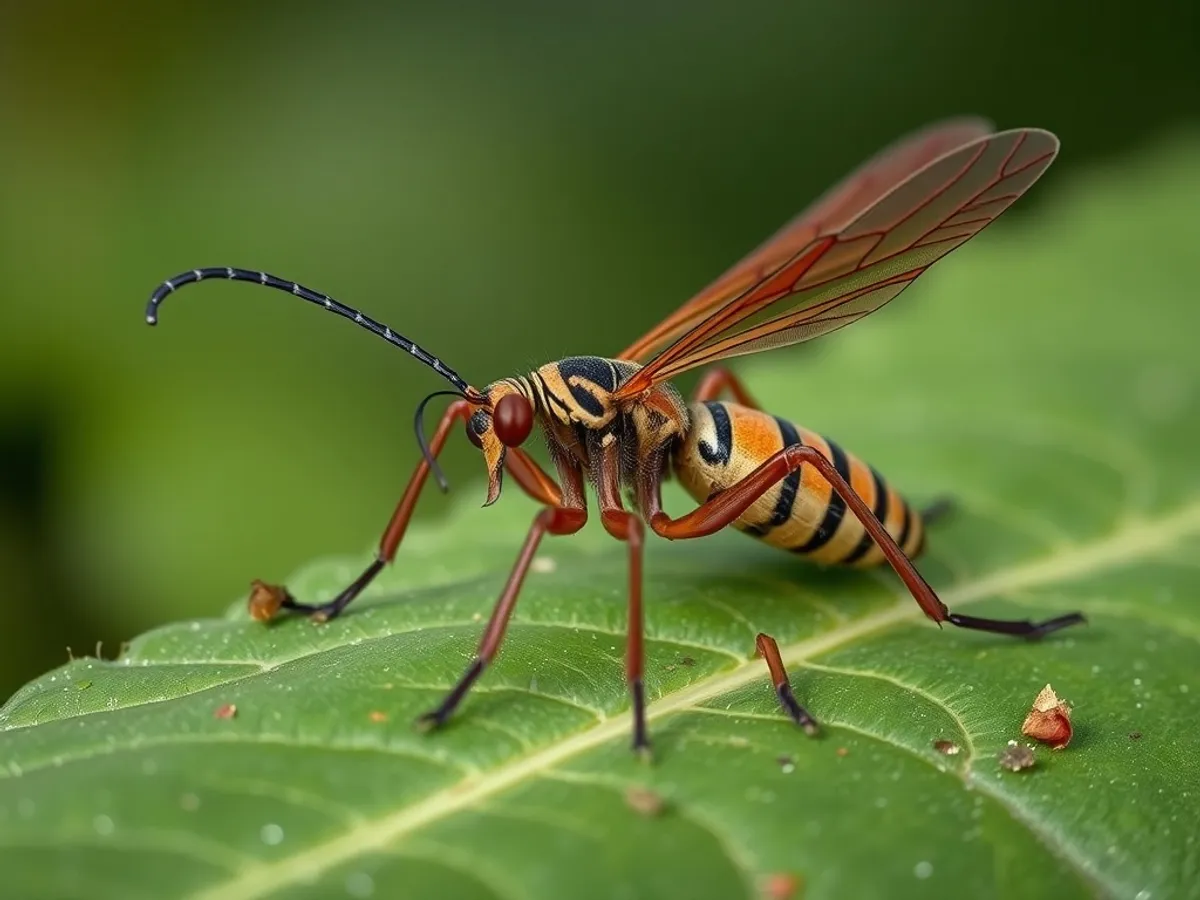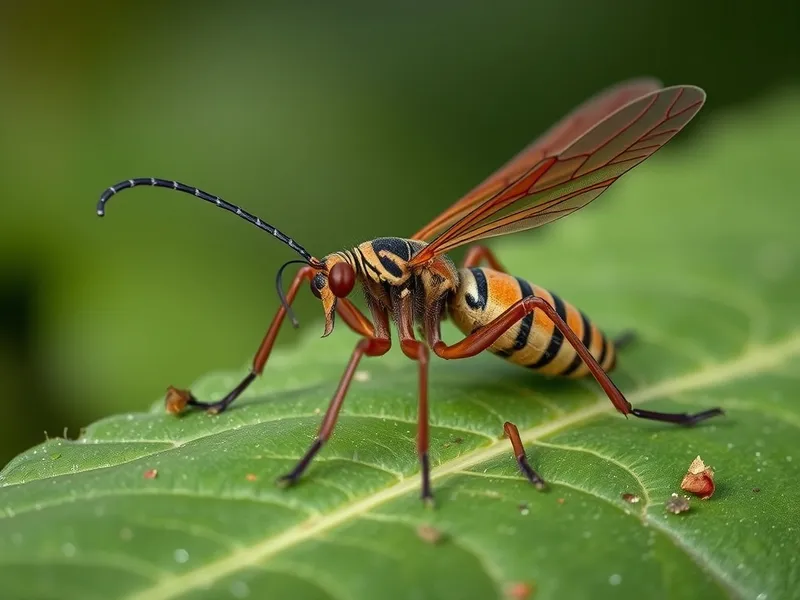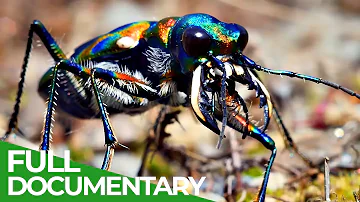
Scorpionfly
Panorpa communis

Meet the Scorpionfly
The scorpionfly is a distinctive insect recognized for its elongated face and the male's tail, which resembles a scorpion's stinger but is actually harmless. Found primarily in Europe and parts of Asia, this insect inhabits damp, wooded areas and hedgerows. Scorpionflies are scavengers, feeding on dead insects, nectar, and sometimes stealing prey from spider webs. Their intricate wings are often patterned and transparent, aiding in camouflage among foliage.
Classification
Invertebrate
Habitat
Woodlands and hedgerows
Diet
Omnivore
Lifespan
1-2 months (adult stage)
Conservation
Least Concern
Weight
20-30 mg
📖Fascinating Facts
Unique Tail
Only male scorpionflies have the bulbous, upturned tail that looks like a scorpion's stinger, but it is actually their genitalia.
Nature's Cleaners
Scorpionflies often feed on dead insects and decaying organic matter, playing an important role in their ecosystem.
Web Thieves
Scorpionflies are known to steal prey caught in spider webs, using their long rostrum to snatch the food without getting trapped.
📋Detailed Description
Panorpa communis, commonly known as the common scorpionfly, is a medium-sized insect measuring 18–25 mm in length, with a wingspan of up to 35 mm. Its most distinctive feature is the elongated, downward-curving rostrum or 'beak,' which houses chewing mouthparts adapted for scavenging. The male's abdomen ends in a bulbous, upturned genital capsule resembling a scorpion's stinger, though it is entirely harmless and used solely for mating. The wings are membranous, transparent, and intricately patterned with dark bands and spots, providing camouflage among vegetation. Scorpionflies possess long, slender legs and antennae, enhancing their sensory perception in dense undergrowth. Their compound eyes afford a wide field of vision, aiding in the detection of predators and prey. The thorax is robust, supporting strong flight muscles for short, fluttering flights between perches. Panorpa communis is primarily active during warm, humid months, favoring shaded, moist environments such as woodland edges, hedgerows, and riverbanks. Both sexes are opportunistic feeders, consuming dead insects, decaying organic matter, nectar, and occasionally live prey. The species plays a vital ecological role as a decomposer and as prey for birds and other insectivores.
💡 Did you know?
Despite their intimidating appearance, scorpionflies are completely harmless to humans and do not possess any venom.
🔬Research & Sources
Wikipedia Summary
Mecoptera is an order of insects in the superorder Holometabola with about six hundred species in nine families worldwide. Mecopterans are sometimes called scorpionflies after their largest family, Panorpidae, in which the males have enlarged genitals raised over the body that look similar to the stingers of scorpions, and long beaklike rostra. The Bittacidae, or hangingflies, are another prominent family and are known for their elaborate mating rituals, in which females choose mates based on the quality of gift prey offered to them by the males. A smaller group is the snow scorpionflies, family Boreidae, adults of which are sometimes seen walking on snowfields. In contrast, the majority of species in the order inhabit moist environments in tropical locations.
Last Modified: 5/25/2025
🎭Behavior & Social Structure
Scorpionflies are solitary and secretive, spending much of their time concealed in low vegetation or leaf litter. They exhibit crepuscular activity, being most active during dawn and dusk when humidity is highest. Feeding behavior is opportunistic; individuals use their elongated rostrum to probe for soft tissues in dead insects, carrion, or decaying plant matter. They are also known to pilfer prey from spider webs, using their agility and long legs to avoid entanglement. Males display territoriality during the breeding season, defending small patches of habitat to attract females. Courtship involves the presentation of nuptial gifts, typically dead insects, which females assess before mating. Scorpionflies are weak fliers, preferring to move by walking or short flights. When threatened, they may drop to the ground and remain motionless, relying on their cryptic coloration for protection.
👶Reproduction & Life Cycle
Breeding occurs from late spring through summer, with peak activity in June and July. Males attract females by offering nuptial gifts, a behavior that increases mating success and may provide nutritional benefits to the female. Copulation is facilitated by the male's specialized genitalia, which securely grasp the female during sperm transfer. Females lay clusters of 20–50 eggs in moist soil or leaf litter, where high humidity ensures successful development. The eggs hatch after 7–14 days, depending on temperature and moisture. Larvae are elongate, caterpillar-like, and possess chewing mouthparts; they feed on decaying organic matter and small invertebrates. The larval stage lasts 3–4 weeks, after which the larvae pupate in the soil. Pupation lasts 1–2 weeks, culminating in the emergence of the adult. There is typically one generation per year in temperate regions.
🛡️Adaptations & Survival
Panorpa communis exhibits several adaptations for survival in its damp, shaded habitats. The elongated rostrum allows access to food sources unavailable to many other insects, such as soft tissues within carrion or prey within spider webs. The cryptic wing patterning provides camouflage against predators. The male's scorpion-like genital capsule is an example of sexual selection, serving as a visual signal during courtship. Weak flight and strong legs are adaptive for navigating dense vegetation and escaping predators by dropping into cover. Larvae are well adapted to a detritivorous lifestyle, with robust mandibles for processing decaying material. The species' ability to exploit a wide range of food sources, including scavenging and nectar feeding, enhances its ecological resilience.
🎨Cultural Significance
Scorpionflies have limited direct cultural significance but are occasionally referenced in folklore due to their unusual appearance. The resemblance of the male's tail to a scorpion's stinger has led to misconceptions about their danger, though they are harmless to humans. In entomological circles, scorpionflies are valued as model organisms for studying the evolution of insect mating systems, sexual selection, and the ecological role of scavengers. Their presence is sometimes used as an indicator of healthy, undisturbed woodland and hedgerow ecosystems.
🔬Recent Research & Discoveries
Recent research on Panorpa communis and related Mecoptera has focused on the evolution of nuptial gift-giving and the role of sexual selection in shaping male morphology. Molecular phylogenetic studies have clarified relationships within the order Mecoptera, revealing ancient lineages and connections to other holometabolous insects. Studies of larval development have highlighted the importance of microhabitat moisture and organic matter for successful metamorphosis. Ongoing research investigates the ecological impact of scorpionflies as decomposers and their interactions with other invertebrates, such as spiders. Climate change modeling is being used to predict future range shifts and inform conservation strategies.
🎥Wildlife Videos

Lethal Poison | Animal Armory | Episode 4 | Free Documentary Nature
Animal Armory - Episode 4: Lethal Poison | Animal Documentary Watch 'Animal Armory - Episode 5' here: ...
Free Documentary - Nature

Scorpions - Death on 8 legs
Wherever they turn up, one thing is always the same: they are photophobic creatures and they are poisonous. Some of them are ...
Free High-Quality Documentaries

Masters Of Disguise: Meet The Creatures Lurking In The Wilderness | Nature Documentary
Insects use ingenious camouflage and defense mechanisms like mimicry and protective coloration to evade predators and blend ...
All Out Wildlife
![The Hidden Mysteries Behind The Dinosaur-Like Insects Of Amazonia | [4K] Wildlife Documentary](https://i.ytimg.com/vi/Y58UtzZNtyU/hq720.jpg?sqp=-oaymwEcCOgCEMoBSFXyq4qpAw4IARUAAIhCGAFwAcABBg==&rs=AOn4CLCLwWX1cKRfcpT6rl3C_AFpQV4GUQ)
The Hidden Mysteries Behind The Dinosaur-Like Insects Of Amazonia | [4K] Wildlife Documentary
A look at the complex relationships of the "mini monsters", insects of the Membracidae family, treehoppers that live amid one of the ...
Wild Habitat - Nature Documentaries

Strategy of Life | Part 1: Nature's Selection | Free Documentary Nature
Strategy of Life - Part 1: Nature's Selection | Wildlife Documentary Watch 'Strategy of Life - Part 2' here: ...
Free Documentary - Nature

Wildlife - Just Insects | Free Documentary Nature
Wildlife - Episode 5: Just Insects | Wildlife Documentary Watch 'Wildlife - Episode 6' here: https://youtu.be/nfpzQyi9UFU Earth is ...
Free Documentary - Nature
🌍Habitat Information
The Scorpionfly typically inhabits Woodlands and hedgerows environments. Scorpionflys have adapted to their environments with specialized features and behaviors.
Primary Habitat:
Woodlands and hedgerows
More detailed habitat information will be available soon.
🛡️Conservation Status
The Scorpionfly is currently classified as Least Concern. Conservation efforts are crucial for preserving this species for future generations.
Common Threats:
- 🏠Habitat loss and fragmentation
- 🌡️Climate change impacts
- 🎯Hunting and poaching
- 🏭Human-wildlife conflict
⚠️Threats & Conservation Challenges
Currently, Panorpa communis is listed as Least Concern, with stable populations across its range. However, local declines may occur due to habitat loss from agricultural intensification, urban development, and drainage of wetlands. Pesticide use poses a potential threat by reducing prey availability and contaminating breeding sites. Climate change may alter the distribution of suitable habitats, particularly affecting moisture-dependent life stages. Despite these challenges, the species' adaptability and broad diet buffer it against severe population declines. Conservation of woodland edges, hedgerows, and riparian zones is important for maintaining healthy populations.
🔬Scientific Classification
Scientific Name
Panorpa communis
Classification Hierarchy
🔍 About Taxonomic Classification
Taxonomic classification is a hierarchical system used by scientists to classify and organize living organisms based on shared characteristics and evolutionary relationships.
The system moves from broad categories (Kingdom) to increasingly specific ones, with each animal's scientific name typically consisting of its Genus and species.
📝Community Notes
Share your observations and insights about the Scorpionfly with our community of wildlife enthusiasts.
Join Our Community
Sign in to share your observations and connect with fellow wildlife enthusiasts.
Sign In to ContributeNo community notes yet
Be the first to share your observations about the Scorpionfly!
Explore Scorpionfly
Select a tab above to learn more about this amazing animal.
📸Photo Gallery
No photos available for this animal yet.
🌟Discover More Wildlife
Continue your journey of discovery with more fascinating animals from our database
